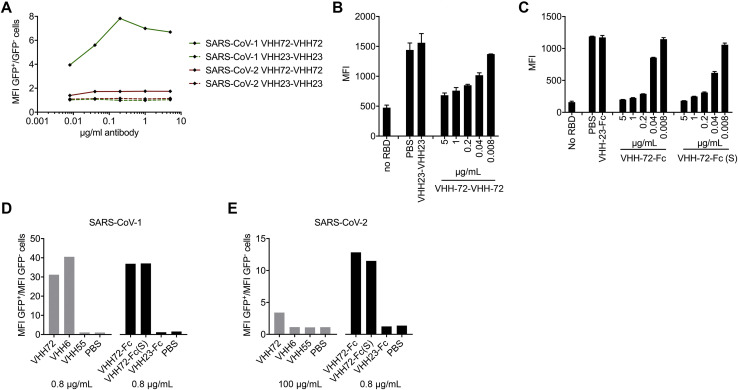Figure S6.
Engineering a Functional Bivalent VHH Construct, Related to Figure 6
(A) Flow cytometry measuring the binding of the bivalent SARS VHH-72 tail-to-head fusion (VHH-72-VHH-72) to SARS-CoV-1 or SARS-CoV-2 S expressed on the cell surface. VHH-23-VHH-23, a bivalent tail-to-head fusion of an irrelevant nanobody, was included as a negative control.
(B) Binding of SARS-CoV-2 RBD-SD1 to Vero E6 cells is prevented by VHH-72-VHH-72 in a dose-dependent fashion. Binding of SARS-CoV-2 RBD-SD1 to Vero E6 cells was detected by flow cytometry in the presence of the indicated bivalent VHHs (n = 2 except VHH-72-VHH-72 and VHH-23-VHH-23 at 5 μg/mL, n = 5).
(C) Binding of SARS-CoV-2 RBD-SD1 to Vero E6 cells is prevented by bivalent VHH-72-Fc fusion proteins in a dose-dependent fashion. Binding of SARS-CoV-2 RBD-SD1-Fc to Vero E6 cells was detected by flow cytometry in the presence of the indicated constructs and amounts (n = 2 except no RBD, n = 4).
(D) Cell surface binding of SARS VHH-72 and SARS VHH-6 to SARS-CoV-1 S. 293S cells were transfected with a GFP expression plasmid together with a SARS-CoV-1 S expression plasmid. Binding of the indicated protein at the indicated concentration is expressed as the median fluorescent intensity (MFI), measured to detect the His-tagged MERS VHH-55 or SARS VHH-6 or SARS VHH-72 or the SARS VHH-72-Fc fusions, of the GFP positive cells divided by the MFI of the GFP negative cells.
(E) Cell surface binding of SARS VHH-72 to SARS-CoV-2. MFI was calculated using the same equation as Figure S6D.

